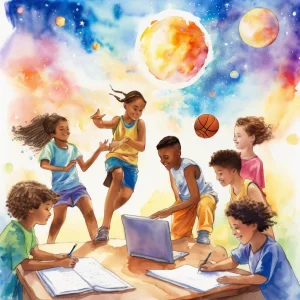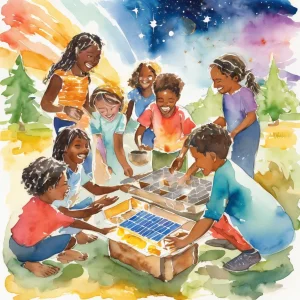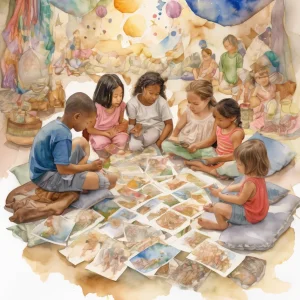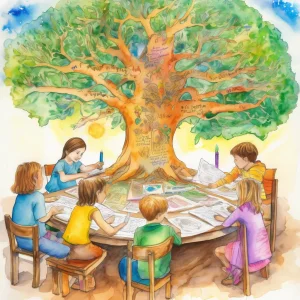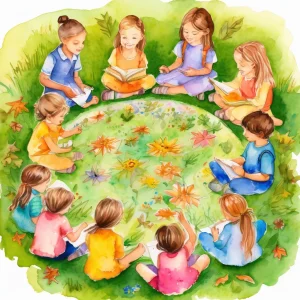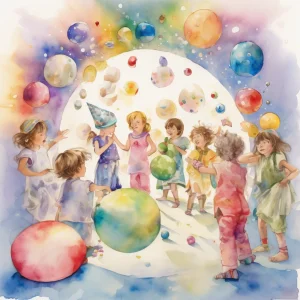Activity
Similar Activities
Digital Beats and Hoop Dreams Coding Adventure
Children’s Age: 9–12 years
Activity Duration: 10 – 20 minutes
An engaging coding activity integrating music production, basketball skills, and teamwork for children aged 9-12 years.
Activity Duration: 10 – 20 minutes
Enchanted Discovery: Nature Scavenger Hunt with a Twist
Children’s Age: 7–8 years
Activity Duration: 10 minutes
An outdoor educational activity for children aged 7-8 involving a nature scavenger hunt with historical items, leading to a nature collage creation.
Activity Duration: 10 minutes
Nature Scavenger Hunt: Adventure in the Wild
Children’s Age: 4–9 years
Activity Duration: 10 minutes
An outdoor, nature-based activity promoting ecological awareness and cognitive development in children aged 4-9 years.
Activity Duration: 10 minutes
Space Adventure Obstacle Course: Galactic Learning Journey
Children’s Age: 6–12 years
Activity Duration: 25 minutes
Get ready for an awesome adventure with the Space Adventure Obstacle Course! You'll crawl through cardboard box spaceships, jump over paper tube asteroids, and follow colorful tape…
Activity Duration: 25 minutes
Exploring Nature's Wonders: Nature Photo Journal
Children’s Age: 12–16 years
Activity Duration: 35 – 45 minutes
The "Nature Photo Journal" activity is tailored for children aged 12 to 16, aiming to boost communication skills and ecological consciousness. Participants will need digital camera…
Activity Duration: 35 – 45 minutes
Sunshine Pizza Delight: Eco-Friendly Solar Oven Party
Children’s Age: 10–12 years
Activity Duration: 35 minutes
The Eco-Friendly Solar Oven Pizza Party is designed for children aged 10 to 12 to learn about sustainability, solar energy, cultural diversity through food, and environmental impac…
Activity Duration: 35 minutes
Cultural Collage Fun: Exploring Diversity Through Art
Children’s Age: 2–3 years
Activity Duration: 15 minutes
"Cultural Collage Fun" is a creative activity designed for children aged 24 to 36 months to develop play skills, cultural awareness, and communication abilities. With magazines, ch…
Activity Duration: 15 minutes
Whispers of the Family Tree of Friendship
Children’s Age: 10–12 years
Activity Duration: 20 – 35 minutes
Family Tree of Friendship is a creative activity that helps children enhance communication skills, academic development, and understanding of family and social relationships. Child…
Activity Duration: 20 – 35 minutes
Adventure Tales: Family Sports Day Storytime Journeys
Children’s Age: 2–3 years
Activity Duration: 10 – 15 minutes
"Family Sports Day Storytime" is a storytelling activity tailored for children aged 24 to 36 months, focusing on language development, communication skills, and family togetherness…
Activity Duration: 10 – 15 minutes
Enchanted Nature Collage Walk Adventure
Children’s Age: 1.5–2 years
Activity Duration: 5 – 10 minutes
Explore nature and boost creativity with the "Nature Collage Walk" activity designed for children. This engaging activity encourages communication, language development, and a love…
Activity Duration: 5 – 10 minutes
Imaginary Adventures: Mini Bowling Feelings Story Game
Children’s Age: 2–5 years
Activity Duration: 10 minutes
An engaging activity promoting sensory development, creativity, reading, and storytelling.
Activity Duration: 10 minutes
Picnic Adventure: Pretend Cooking Play for Toddlers
Children’s Age: 2–3 years
Activity Duration: 10 – 30 minutes
An imaginative activity where children (ages 2-3) engage in pretend cooking during a picnic adventure.
Activity Duration: 10 – 30 minutes



